Table of Contents
Why Allrecipes?
Allrecipes is a lot more than a recipe site; it’s a social network for food lovers. Since its inception in 1997, the publisher launched 38 successful cooking-related sites before combining them all to form Allrecipes. It has a two-decade-long journey behind it which shows us how a small site can grow up by leaps and bounds to become the largest food website on the internet.
During all these years, Allrecipes has implemented many unique strategies that helped it grow faster than its peers. The graph below shows the exponential rise of the site in the last two decades. It’s one of the best publishers if we want to learn the art of winning a niche.
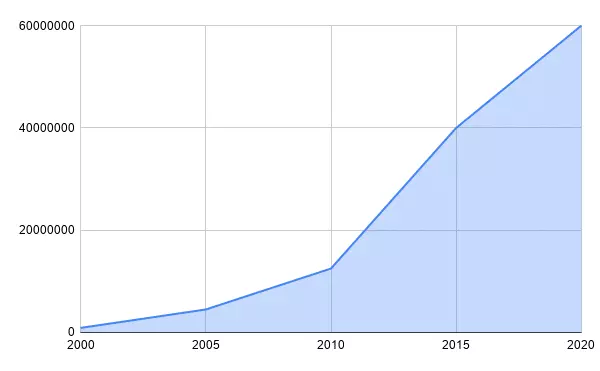
Monthly Unique Visitors
Traffic Data: Source 1, Source 2, Source 3, Source 4, Source 5
How it all started?
1997
Many successful companies have a common story – an entrepreneur faces a personal problem, finds its solution, recognizes a business opportunity in the solution, and then capitalizes it. Something similar happened with Allrecipes as well. The idea of starting a recipe-sharing site stuck with Tim Hunt, a UW anthropology graduate student when he couldn’t get his mom’s homemade cookie (Src). He started the experiment with CookieRecipe.Com and found that there’s a lot of desire among cooking enthusiasts to share their favorite recipes with like-minded people. CookieRecipe became an instant success.

But CookieRecipe was dedicated to only one type of food, the need for expansion was obvious. So the creators of CookieRecipe kept spinning off new sites – Cakerecipe.com, Chickenrecipe.com, Pierecipes.com, Beefrecipe.com, and so on. The total number of sites reached 38 when the publishers consolidated them into AllRecipes.com around 2001.
Where are they today?
Today, Allrecipes is the preferred recipe source for 85 million home cooks (Src). Its visitors are consuming 3 billion pages annually. It has 19 global sites that are serving in 24 countries in 12 languages. 95 Recipes are viewed on Allrecipes every second.
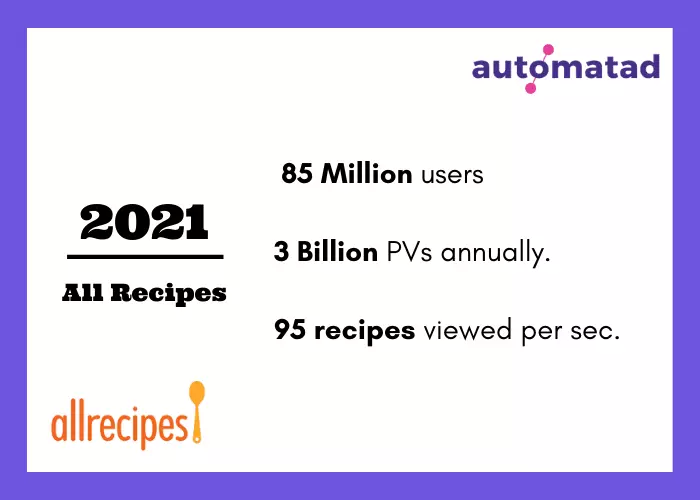
It has an audience of 3.5 million on Facebook (Src), 1.4 million on Instagram (Src), 90k on Pinterest (Src), 71k on Twitter (Src), and 1.5 million on YouTube (Src).
Becoming Allrecipes
I. The Seed Money
1997
The Seattle based Allrecipes had a humble beginning. Its initial funds came from angel investors. Its target audience was the busy home-cooks, and the site offered them a community where they could share their favorite recipes and cooking experience with other cooks. With consistent growth, the site became the preferred recipe and cooking resource for its audience.
“The cooks who come to Allrecipes.com aren’t coming to romanticize recipe pictures, they’re coming to find tried and tested recipes they can make for their families that night.”
– Bill Moore, Former CEO, Allrecipes
The users submitted their recipes, which were reviewed, evaluated, and made better by the editors. This process made sure that the content on the site always had the best quality. The content kept evolving as the users suggested tweaks in the recipes through comments (Src).
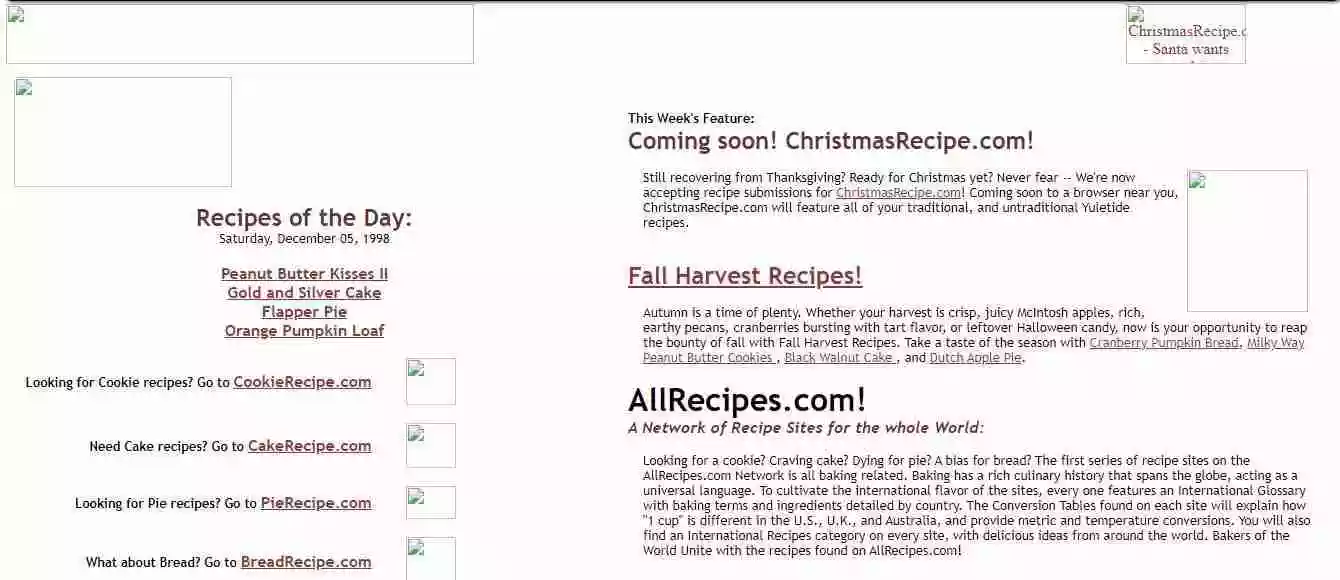
(Allrecipes presenting itself as a network of recipe sites in its early days in 1998)
II. New Fundings and Further Growth
2000
At the beginning of the year 2000, Allrecipes successfully raised $2.5 million (Src). After the funding, it hired Bill Moore, top talent from Starbucks who joined Allrecipes as the CEO of the company. The website was receiving 900,000 unique monthly visitors during that time and it was growing at a rate of 20% Month-on-Month.
Later, in the same year, Allrecipes raised $6.5 million from multiple investors in another round of funding. Mind you, that this was the period of the dot-com bubble when no one was ready to bet on online ventures. It was impressive to see that a content-based website was approaching profitability while growing with its 50 employees during this time. (Src).
It reached close to 1 million monthly users without any marketing budget at all. Doing so was not easy because it was the early 2000s when social media sites like Facebook and Twitter didn’t exist. But the nature of the content was such that people wanted to share it. The tradition of sharing recipes with your friends and family is age-old. The email was the best way of sharing content during this era, and it gave the necessary push to Allrecipes for rapid growth.
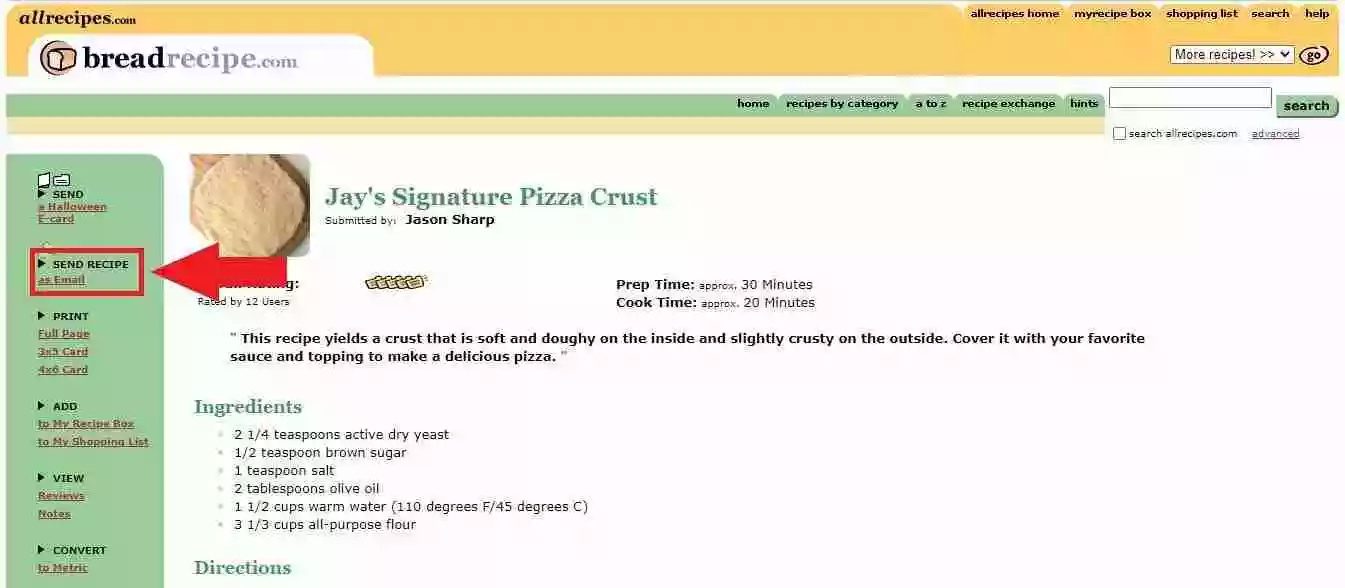
Allrecipes made recipe sharing easy for its visitors.
Another strength of the publisher was a diversified list of potential sources of revenue. For example:
- The publisher charged food manufacturers and grocery stores for placing their coupons on the site.

- It charged for placing notices about free samples that could be sent to the consumer’s home.
- The recipes generated shopping lists in the form of recipe ingredients, so there was scope for affiliate marketing.
- The site was all about food, so it was ideal for food makers to sponsor the site.
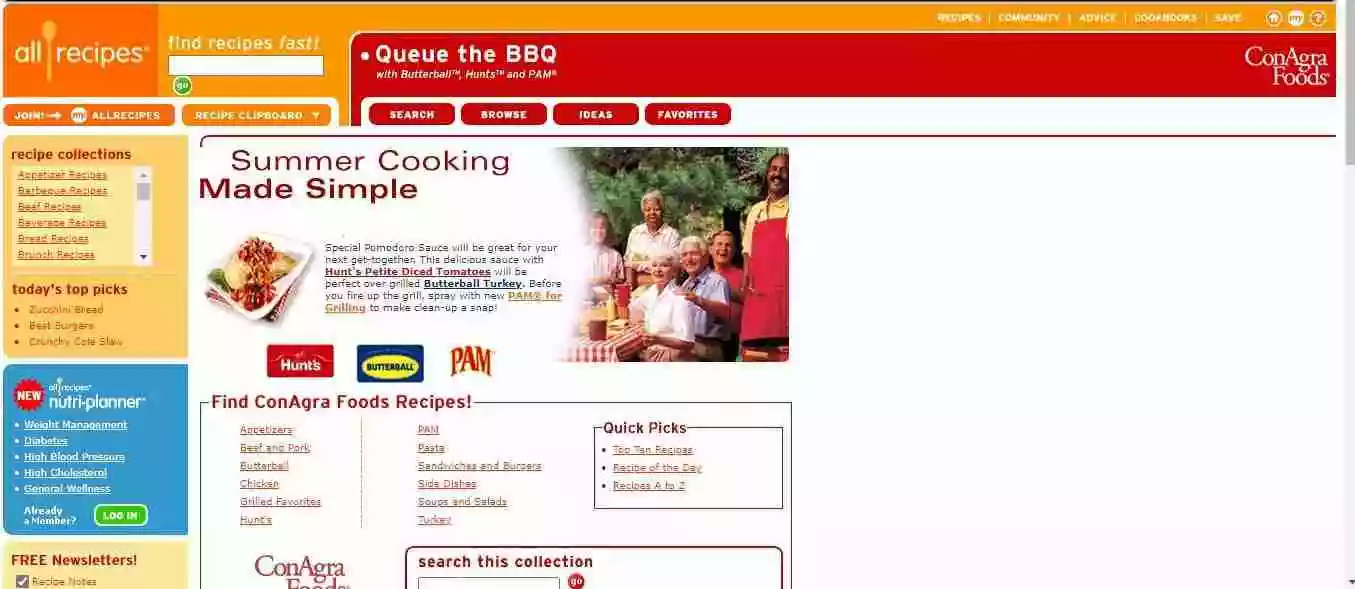
- Another way was to syndicate the content to other sites.
- And then, of course, you can sell kitchenware to your users when all you are talking about is food and cooking.
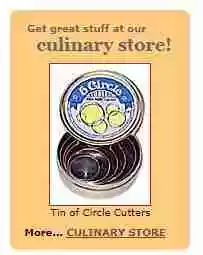
III. Leveraging Visitor Behaviour
2002
Knowing the behavior of the content consumer can be a great strength for any publisher. Allrecipes used this knowledge to improve retention, create the right content, and to acquire more sponsorships.
Retention
For retention and increasing the pageviews, Allrecipes closely observed which recipes were getting popular at a given time. To do so, the publisher tracked the number of page views and the keywords that the readers were using to reach the recipe pages. It also used the data from previous years to predict the recipes that were about to be in demand. Once it knew the upcoming trend, it used to change the headlines and creatives to attract other users to the same trending pages.
Conversions
Allrecipes also studied the readers’ movement around the site. It found out the places where most of the consumers would reach while they are open to suggestions. For example, users on the recipe search results page or the recipe directory page are looking for recommendations. These locations on the site were leveraged by placing ads of new cookbooks by the publisher, newsletter sign-up forms, sponsored recipe collections, etc. for best results.
New Content Development
To develop new content, the publisher observed the common factors among the popular recipes. Characteristics such as nutritional value, cooking time, seasonality, ingredients, etc. can be studied to find the commonality among the recipes. So, suppose many recipes with less than 15 minutes of cooking time are most visited by the consumers, then the publisher would know that more such recipes should be added to the website. Other products such as cookbooks could also be developed with such insights.
Finding Sponsorships
Approaching the right sponsors also becomes easier when you know your audience. Allrecipes began contacting packaged goods companies like Hershey Foods Corporation and offered them long-term sponsorships. It offered them custom proposals where the food companies would sponsor branded content hubs with a collection of recipes. Other offers included sponsorships of specific recipes, keyword sponsorships, newsletter sponsorships, etc (Src).
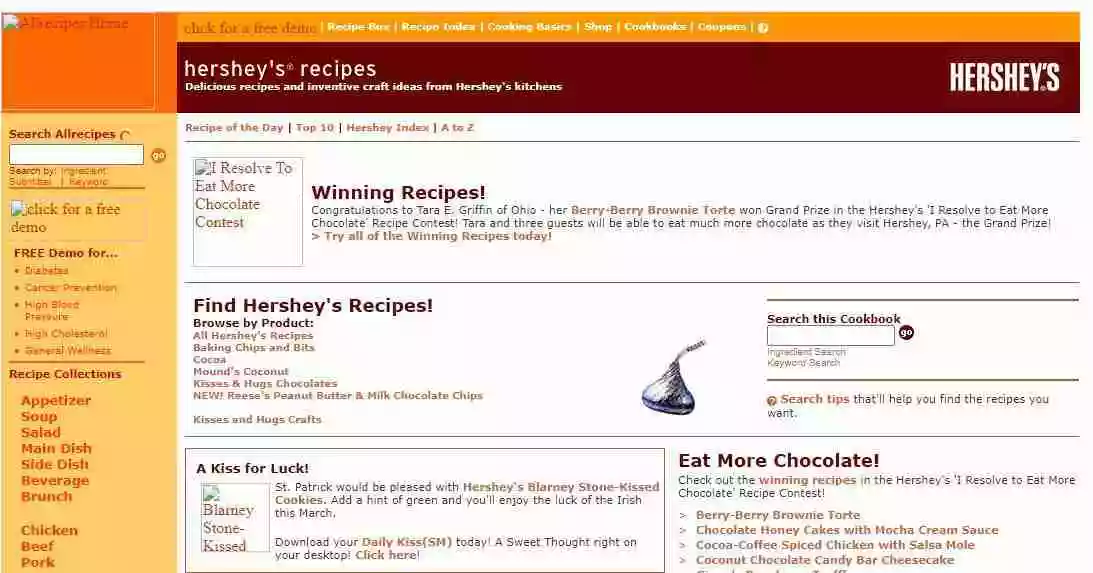
Not only behavior, but it is also important to know who your audience is. When you can define your audience, then you know the exact content that your audience will prefer. Allrecipes’ Vice President Esmee Williams draws a clear portrait of the site’s users which makes it easy for the site to create the right content. She says,
“They prefer five to seven ingredients that they can find in their pantries or at a midrange grocery store. They want nice, clean pictures of each dish. They don’t want to spend more than an hour of cooking.”
IV. Dinner Spinner Mobile App
2008
In 2008, Allrecipes launched its iPhone app called Dinner Spinner. It helped users to search for popular recipes and discover new dinner ideas (Src). The app came within a few months of Apple launching the App Store with mere 500 apps (Src). It shows how quick the publisher was with adopting new technologies. Such qualities help publishers in staying ahead in the trend and take the first-mover advantage.
Gradually, Allrecipes expanded to other popular platforms namely Android, Windows, and Fire OS built for Amazon’s Kindle Fire tablets (Src). The site’s massive reach helped it in gaining huge numbers of downloads, for instance, the app has been downloaded more than 5 million times on the Android platform .
The app helps the publishers in keeping their audience closer. App notifications can bring additional site visits. Some advertisers target a mobile-only audience, so you can cater to such advertisers if you have an app. There are many more opportunities that an app brings to a publisher and Allrecipes tapped all of them with the Dinner Spinner app.
But your audience keeps using your app only when it delivers value to them. Allrecipes kept adding features like search by dishes, cooking time, ingredients, making shopping lists, sharing recipes, scanning ingredients to find recipes, and many more features that made the life of home cooks easier. The utility provided by the app helped it to become the best app in the cooking category (Src).
So, we can say that Allrecipes created additional sources of traffic with the help of its apps. By providing the right value to its users, it made sure that the traffic from the app is sustainable.
V. From Meal Plans to Shoppable Programmatic Display Ads
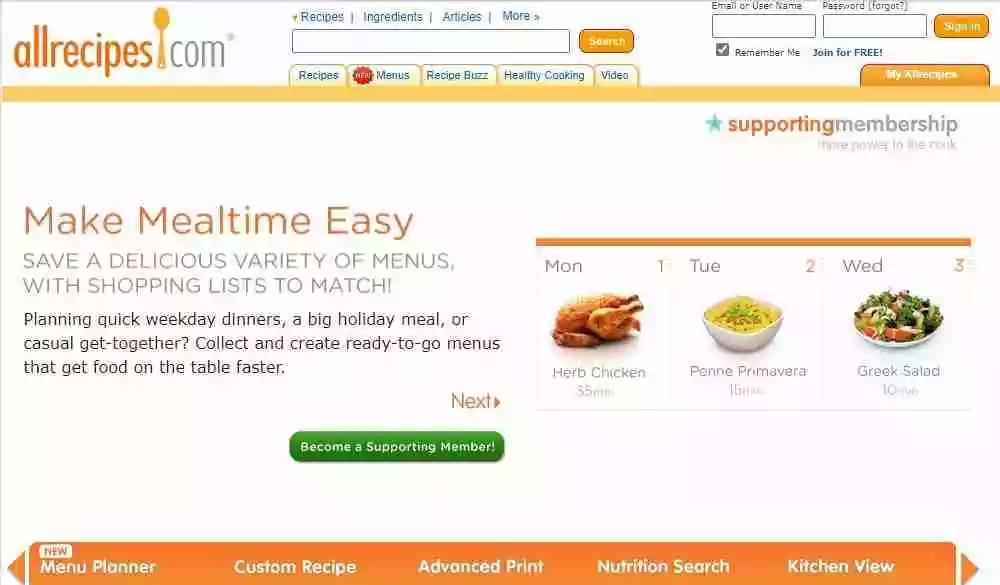
2011
When Allrecipes was in the hands of Reader’s Digest, it introduced meal planning tools at the request of its users (Src). The tool could be used to plan 10 days of meals at a time. It had drag-and-drop functionality to create and edit meals. It had over 1,300 customizable menu ideas to make the work easier for the users. It offered shopping lists that populated automatically from the meal plans. The meal planning utility was the starting point of a new evolution.
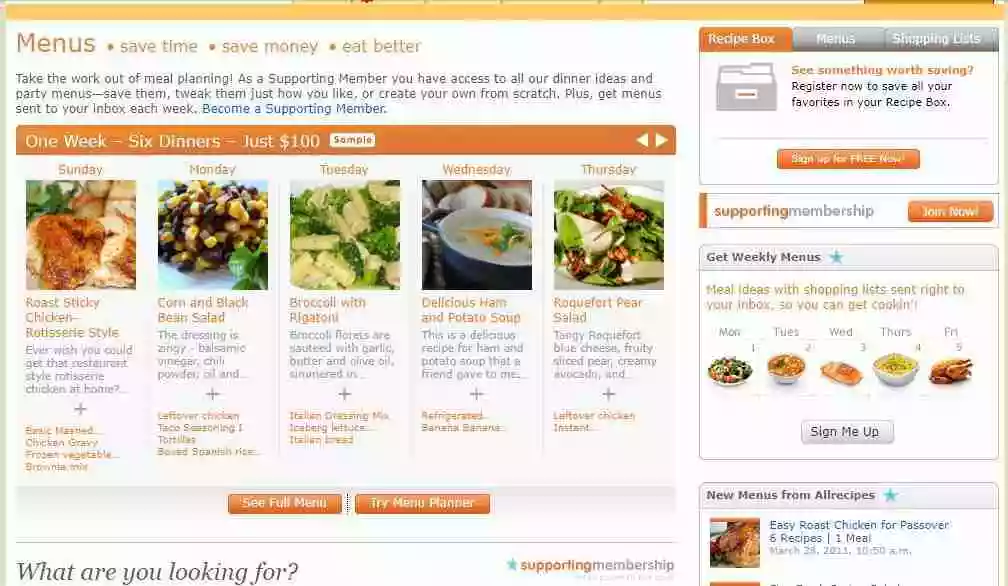
Acquisition by Meredith
But, Reader’s Digest was a diverse company. It was printing magazines from 1922 and was dealing with books, websites, music, and video products. Being unable to keep up with the time, Reader’s Digest revenue kept falling, and ultimately it had to file bankruptcy. Despite the poor financial health, Allrecipes was still its crown jewel. So, there was no lack of interested buyers when Reader’s Digest put Allrecipes for sale. The bidders included Amazon, AOL, Random House, and Food Network (Src). But ultimately, Meredith acquired the site for $175 million (Src).
Shoppable Display Ads
Meredith preserved the meal planning feature on Allrecipes. It also started programmatic advertising in the same year (Src). After four years, the publisher partnered with The Trade Desk to take its programmatic ads to the next level.
With the help from The Trade Desk, Meredith added shoppable programmatic display ads to the meal planning section. The ingredients in the recipes could be directly added to the user’s shopping cart. The display ads for these ingredients were bought by the advertisers with The Trade Desk’s programmatic solution (Src). Meredith leveraged its first-party data to make Allrecipes’ inventory even more lucrative to the buyers. The advertisers could use a combination of audience behavioral insights, SKU-level product data, retail store locations, local weather, and geo-targeted promotions to build consideration and drive in-store purchases.
So, Allrecipes began with a simple meal planning tool and created a unique display ad placement out of it. Similarly, it started with programmatic ads used them distinctively by making them shoppable and equipped with first-party data. By evolving and combining both the tools, it offered the advertisers something that no other publisher could offer.
In the words of Meredith’s VP of Data & Programmatic Solutions, Chip Schenck:
“To date, publishers’ way of ‘productizing’ display inventory between PMPs and the open Web was rudimentary at best, Meredith’s new shoppable display platform is an example of leveraging a publisher’s unique capabilities – data, technology, talent assets, and more – to advance programmatic advertising to the next stage in its evolution.
VI. From Digital to Print
2013
There’s a wide consensus in the publishing industry that print is dying. Every legacy publisher has moved to digital and for many of them, digital has become the main business. Allrecipes is the rarest of the rare publishers that moved oppositely, and to everyone’s surprise, it succeeded in doing so.
In November 2013, Allrecipes printed its first bi-monthly magazine for 500,000 readers. After just one month, the publisher realized that the demand for the magazine is a lot more than expected. So, for the next issue, Allrecipes is expected to sell 650,000 copies. By September 2014, the number reached 900,000 and in Feb 2015, the publisher added another 200,000 copies. In short, the magazine grew by 120% just after publishing 8 issues (Src).
Factors Behind Success
So how did Allrecipes succeed in an adverse market? Here are some reasons:
- The first factor to help the publisher was the brand image. Allrecipes was already popular, so even the first issue of the magazine was not a completely unfamiliar product for the target audience.
- Second, the magazine launch was not a random move. Allrecipes used focus groups, online tests, newsstand tests, and more to find out whether there is a demand for a printed magazine.
- Third, the publisher leveraged its reach to sell the magazine. Allrecipes already had a community of 40 million home cooks. It had to find the users who have experienced the brand digitally and are ready to pay for the print experience (Src).
The success of the printed magazine shows us how publishers can leverage their brand image to succeed in adjacent markets. But, you have to be analytical in your approach. If you have done the right calculation and validated your assumptions, then success becomes easier.
VII. A Mobile-First Social Platform
2017
When Google realized that more and more users are using its services on mobile devices, it started emphasizing the importance of a mobile-first approach. Soon, it started boosting the ranks of mobile-friendly pages (Src), every publisher without a mobile-friendly site started losing a significant amount of organic traffic. It became inevitable for publishers to adopt responsive website designs. Allrecipes was no different. The major reason behind the users visiting Allrecipes was ‘cooking’, and a mobile phone is the most convenient device when the user is reading the recipe in the kitchen. So, becoming mobile-first became a priority for the publisher.
Allrecipes was not only ready for the challenge, but it had an even larger vision. It wanted to be a mobile-first social platform (Src). A social platform is more engaging than a publishing site. Engagement translates to higher retention rates and better SERP rankings. Allrecipes added tons of additional features to transform the site into a social platform.
Now, the users could integrate their other social media accounts with Allrecipes. They could search, save, and interact with the recipes on the site. Every user had a personalized feed on his homepage. The users could follow each other. They could show if they have completed a recipe, review it, and share it on other social media platforms. In a nutshell, this recipe had all the ingredients to cook a perfect dish called “social media platform.”
Hyperlocal Advertising
40% of the Allrecipes users shop for ingredients within 24 hours of searching the site (Src). Most of this shopping could take place locally. This created a unique opportunity for Allrecipes. Helping users in finding the best deals around them could create value that can later be converted into business.
To capitalize on the situation, Meredith, the parent company of Allrecipes, acquired Grocery Server (Src). The technology from Grocery Server could deliver native placements for the offers on the relevant products that are available nearby. By this time, 70% of the site’s visitors were on mobile, so highly relevant local ads could be served to users while they were in the market.
Telling about the best offers in the nearby stores to an in-market audience will surely bring more conversions. Brands like Target, Unilever, and Del Monte witnessed an increase in sales, basket size, and return on investment when they used the hyper-local advertising on Allrecipes (Src). High conversion rates attract more businesses to advertise on your site. Allrecipes was set to attract more advertisers from the food and consumer packaged goods space.
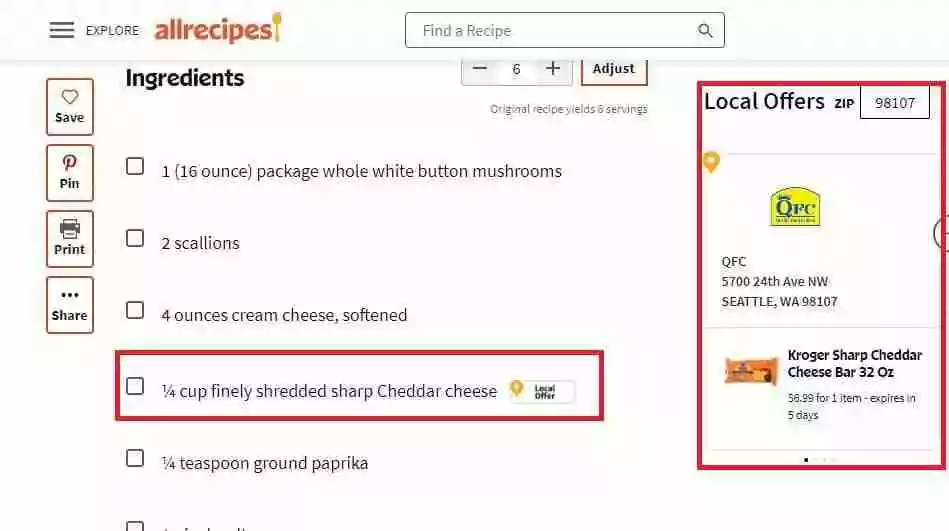
By serving highly contextual but hyper-local ads, Allrecipes strengthened its position in front of the businesses in the food category. It not only helped its users but also its clients in a quantifiable manner. The publisher’s niche allowed it to offer unique value to its users and clients. Similarly, every niche brings distinct opportunities that have the potential to make you the best among your competitors.
VIII. Affiliate Partnership with Amazon
2017
After shoppable ads, Allrecipes kept expanding its ability to help its users with buying recipe ingredients. It started a partnership with Amazon, where the users could not only shop for the ingredients, but they could also get them delivered to their doorsteps. A simple green button that said ‘buy this recipe now’, would take the user to a cart filled with all the grocery items required to prepare the dish.

Amazon Fresh, the service that delivered the grocery, was available only in a limited number of states. The option to buy the products was also visible only in the states where the service was active. Allrecipes received a commission for every sale made through its website (Src). So, while shoppable display ads were already generating revenue for Allrecipes, the addition of affiliate revenue from selected states of the US brought further diversification in its ad revenue.
IX. Current Setup for Programmatic Ads
2020
We can see 8 bidders on Allrecipes’s article page. It means that the publisher also sells its inventory through auctions. It’s done through header bidding. You get higher revenue for your ad inventory when you auction it among multiple bidders instead of selling it through a single buyer. These multiple bidders are connected to the publisher via a header bidding wrapper. The bidders we see below are all well known SSPs in the market.
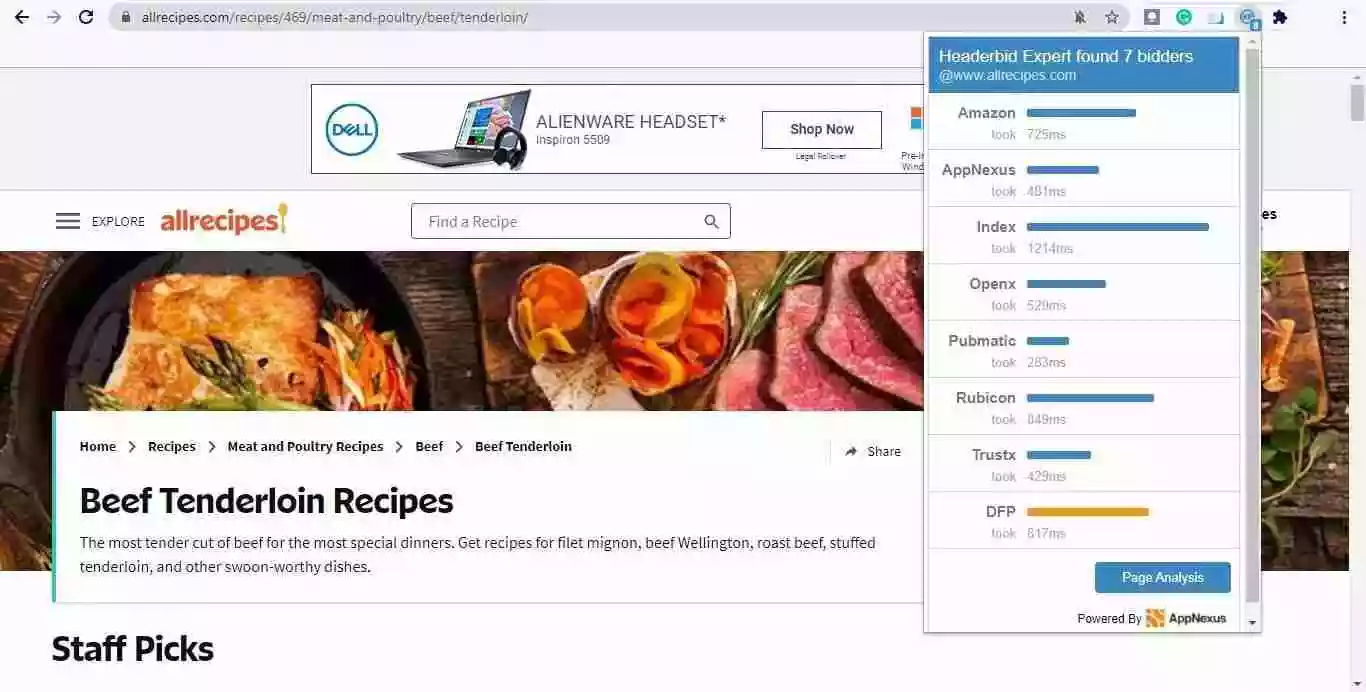
Allrecipes leverages its first-party data to command even higher rates for its programmatically sold inventory. First-party data increases the addressability of your audience, thereby making it more desirable for the bidders. In other words, bidders bid higher if you can make your first-party data available to them. The recent trends show that the use of first-party data will soon become a norm in the industry. Services like Segment and Chartbeat can be seen on the website that can be used to build first-party data for the publisher.
Mobile App
Allrecipes monetizes its app traffic with display ads. You’ll find the popular 300×250 banner and sticky container at the bottom of the viewport.
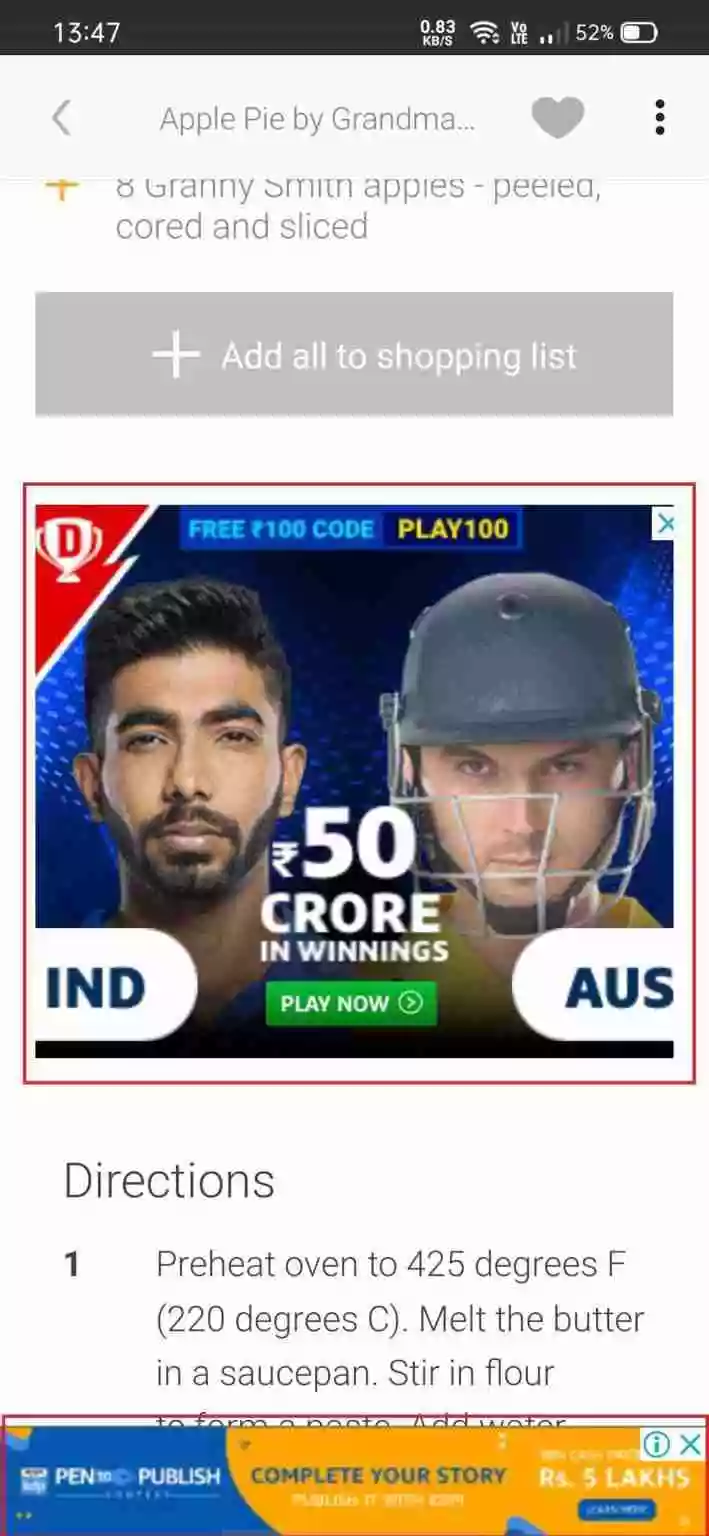
Both these ad sizes provide an un-intrusive ad experience. Of course, the publishers keep testing and experimenting with the ads on the app and the website. So, you may find many other ads from time to time. Additionally, there’ll be ads in the form of sponsorships, native ads, and branded content that are not app-specific but the traffic from the app still contributes to the revenue generated from them.
Conclusion
Allrecipes gives us many lessons to learn to succeed in the publishing business. As a publisher, always thrive to deliver value to your users. Allrecipes helped its users in finding the right recipes. Whether it’s their website, or app, or magazine, they were all focused on helping the users. As a result, it was able to create a closely-knit community that generated revenue.
Allrecipes always act based on facts, not assumptions. It analyzed consumer behavior and used the findings for creating content, increasing retention, placing ads, and finding sponsors. Similarly, it conducted all the necessary tests before starting the printed magazine to make sure it is an assured success.
Being responsive also helped the publisher a lot. It introduced new features on its site and apps at the users’ request. It became a mobile-friendly site once Google changed its algorithm. It converted itself into a social platform after seeing the users’ growing interest in social media sites. Being responsive helped it in staying relevant even after two decades since its launch.
Having an evolutionary approach helped it in being unique and the best in its market. Converting normal display ads into hyper-local shoppable ads, helping with meal plans, and turning it into a unique business opportunity, from programmatic to affiliate ads in selected states, all these incidents show how Allrecipes kept growing with time.
So, this was the story of Allrecipes which started with a single recipe and later became the biggest food website on the internet. We hope that you’ve learned a lot of strategies to fly your business in the Allrecipes way.
Check out more such success stories in our Becoming Series. You can contact us for all your website monetization needs, including header bidding!























